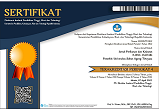Efektivitas pakan moist berbasis singkong dan keong pada budidaya lobster air tawar (Cherax quadricarinatus)
Abstract
The feed plays a critical role in the success of freshwater lobster cultivation, but it often presents challenges due to its relatively high cost, accounting for up to 60% of production expenses. To address this issue, farmers in Sukabumi have devised various alternative feeds by harnessing different protein sources to reduce the expenditure on commercial pellets. One such innovation is a moist feed composed of a blend of pellets, cassava, and snails in a ratio of 1:1:1.4. However, there hasn't been prior testing of its nutritional content. Consequently, this study aims to evaluate the nutritional composition of this moist feed and assess its impact on the growth of freshwater lobsters as well as water quality. For this research, a total of 300 lobsters, ranging in size from 7 to 10 grams, were reared in fiberglass tanks. The lobsters were fed twice daily. The proximate analysis of the cassava and snail-based moist feed revealed protein content (20.52%), fat (2.61%), carbohydrates (12.87%), moisture content (50.64%), and ash content (13.36%). The lobsters exhibited a growth rate of 0.3% per day, and the water quality remained favorable, with parameters such as temperature (23-25°C), pH (6.5-7), dissolved oxygen (5-7 mg/L), nitrate (1.907 mg/L), nitrite (0.141 mg/L), ammonia (0.442 mg/L), phosphate (0.032 mg/L), and alkalinity (237.4 mg CaCO3/L) within acceptable ranges. These findings suggest that the moist feed provided by farmers lacks sufficient protein content to fully meet the nutritional requirements of lobsters, resulting in slower growth. On the other hand, water quality remains conducive for successful lobster farming.
Keywords
Full Text:
PDFReferences
Akmal SG, Santoso A, Yonvitner, Yuliana E, Patoka J. 2021. Redclaw crayfish (Cherax quadricarinatus): Spatial distribution and dispersal pattern in Java, Indonesia. Knowledge and Management of Aquatic Ecosystems. 422 (16): 1-6. DOI: https://doi.org/10.1051/kmae/2021015
Budiardi T, Irawan DY, & Wahjuningrum DD. 2008. Pertumbuhan dan kelangsungan hidup lobster capit merah Cherax quadricarinatus dipelihara pada sistem resirkulasi dengan kepadatan yang berbeda. Jurnal Akuakultur Indonesia. 7 (2): 109–114. http://journal.ipb.ac.id/index.php/jai
Camargo JA, Alonso Á. 2006. Ecological and toxicological effects of inorganic nitrogen pollution in aquatic ecosystems: A global assessment. In Environment International. 32 (6): 831–849. DOI: https://doi.org/10.1016/j.envint.2006.05.002
Fajriyah I, Ilmi IMB. 2020. Karakteristik kimia dan sensoris kerupuk pasir keong sawah (Pilla ampullacea) sebagai cemilan sehat sumber protein. Ghidza: Jurnal Gizi Dan Kesehatan. 4 (2): 206–215. DOI: https://doi.org/10.22487/ghidza.v4i2.133
García-Guerrero M, Hernández-Sandoval P, Orduña-Rojas J, Cortés-Jacinto E. 2013. Effect of temperature on weight increase, survival, and thermal preference of juvenile redclaw crayfish Cherax quadricarinatus. Hidrobiológica. 23 (1): 73–81.
Haddaway NR, Mortimer RJG, Christmas M, Dunn AM. 2013. Effect of pH on growth and survival in the freshwater crayfish austropotamobius pallipes. Freshwater Crayfish. 19 (1): 53–62. DOI: https://doi.org/10.5869/fc.2013.v19.053
Hartman E. 2018. The Effects of Aqueous Nitrate on Freshwater Crayfish. http://ideaexchange.uakron.edu/honors_research_projects/679
Iskandar R, Fitriadi S. 2017. Analisa proksimat hasil olahan pembudidaya ikan di Kabupaten Banjar Kalimantan Selatan. Ziraa’ah. 42 (1): 65–68.
Jana B, Sarkar D. 2005. Water quality in aquaculture - Impact and management: A review. The Indian Journal of Animal Sciences. 75 (11): 1354–1361.
Kozák P, Máchová J, Policar T. 2005. The effect of chloride content in water on the toxicity of sodium nitrite for spiny-cheek crayfish (Orconectes limosus Raf.). Bulletin Français de La Pêche et de La Pisciculture. 376–377: 705–714. DOI: https://doi.org/10.1051/kmae:2005027
Mallya YJ, Thorarensen SPH. (2007). The Effects of Dissolved Oxygen on Fish Growth in Aquaculture. UNU-Fisheries Training Programme. https://www.grocentre.is/static/gro/publication/58/document/yovita07prf.pdf
Mustapha. 2019. Importance of pH Control in Aquaculture. https://www.researchgate.net/publication/340870601
Patoka J, Wardiatno Y, Mashar A, Yonvitner, Wowor D, Jerikho R, Takdir M, Purnamasari L, Petrtýl M, Kalous L, Kouba A, Bláha M. 2018. Redclaw crayfish, Cherax quadricarinatus (von Martens, 1868), widespread throughout Indonesia. BioInvasions Records. 7 (2): 185–189. DOI: https://doi.org/10.3391/bir.2018.7.2.11
Putra AN, Indayah U, Nokiyah N, Syamsunarno MB. 2022. Improving quality of cassava peel meal as raw material for tilapia feed. Depik. 11 (3): 319–326. DOI: https://doi.org/10.13170/depik.11.3.24620
Qian D, Yang X, Xu C, Chen C, Jia Y, Gu Z, Li E. 2021. Growth and health status of the red claw crayfish, cherax quadricarinatus, fed diets with four typical plant protein sources as a replacement for fish meal. Aquaculture Nutrition. 27 (3): 795–806. DOI: https://doi.org/10.1111/anu.13224
Romano N, Zeng C. 2009. Subchronic exposure to nitrite, potassium and their combination on survival, growth, total haemocyte count and gill structure of juvenile blue swimmer crabs, Portunus pelagicus. Ecotoxicology and Environmental Safety, 72 (4): 1287–1295. DOI: https://doi.org/10.1016/j.ecoenv.2009.02.003
Samad APA, Isma MF, Ayuzar E, Ilhamdi, Humairani R, Santi F. 2022. Growth and survival rate of freshwater lobster (Cherax quadricarinatus) fed different forage feed. IOP Conference Series: Earth and Environmental Science. 956 (1). DOI: https://doi.org/10.1088/1755-1315/956/1/012006
Saoud IP, Garza DYA, Ghanawi J. 2012. A review of nutritional biology and dietary requirements of redclaw crayfish Cherax quadricarinatus (von Martens 1868). Aquaculture Nutrition. 18 (1): 349–368. DOI: https://doi.org/10.1111/j.1365-2095.2011.00925.x
Saoud IP, Ghanawi J, Thompson KR, Webster C D. 2013. A review of the culture and diseases of redclaw crayfish Cherax quadricarinatus (Von Martens 1868). Journal of The World Aquaculture Society. 44 (1): 1–29.
Sowers ANDA, Young SP, Isely JJ, Browdy CL, Tomasso JR. 2004. Nitrite toxicity to Litopenaeus vannamei in water containing low concentrations of sea salt or mixed salts. Journal of the World Aquaculture Society. 35 (4): 445–451. DOI: https://doi.org/10.1111/j.1749-7345.2004.tb00109.x
Sugiura, S. H. (2018). Phosphorus, Aquaculture, and the Environment. Reviews in Fisheries Science and Aquaculture. 26 (4): 515–521. DOI: https://doi.org/10.1080/23308249.2018.1471040
Yang Y, Xu W, Jiang Q, Ye Y, Tian J, Huang Y, Du X, Li Y, Zhao Y, Liu Z. 2022. Effects of Low Temperature on Antioxidant and Heat Shock Protein Expression Profiles and Transcriptomic Responses in Crayfish (Cherax destructor). Antioxidants. 11 (9). DOI: https://doi.org/10.3390/antiox11091779
Yolanda S, Santoso L, Harpeni E. 2013. Pengaruh Substitusi Tepung Ikan dengan tepung ikan rucah terhadap pertumbuhan ikan nila gesit (Oreochromis niloticus). E-Jurnal Rekayasa dan Teknologi Budidaya Perairan. 1 (2): 95–100.
DOI: http://dx.doi.org/10.33512/jpk.v13i1.22280
Refbacks
- There are currently no refbacks.



_-_Copy1.png)